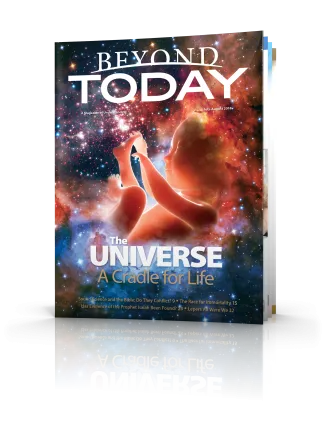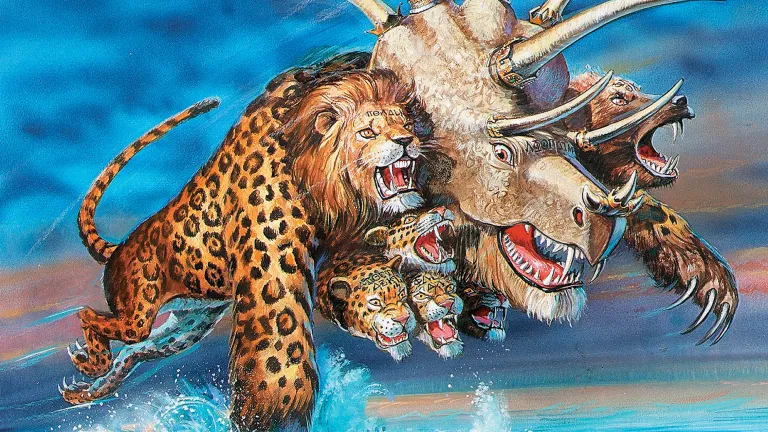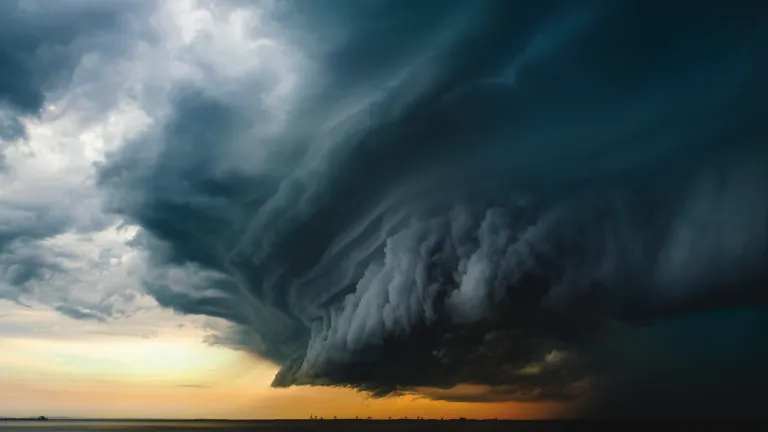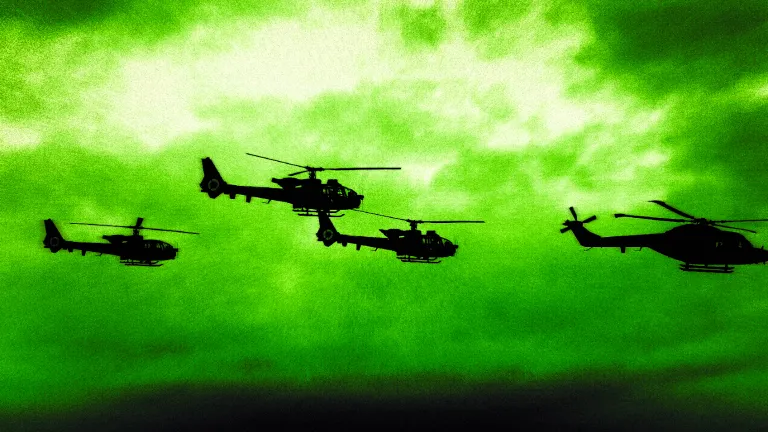Bible Prophecy and You: The Beast, the False Prophet and the Antichrist
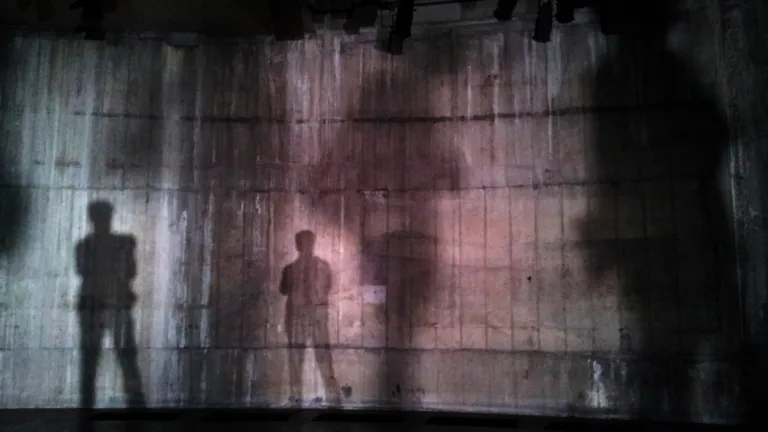
What does Bible prophecy tell us about the mysterious figures called the Beast, the False Prophet and the Antichrist? How can we understand?
Welcome to the 12th lesson in the “Bible Prophecy and You” series!
Today one can hear or read every imaginable interpretation or speculation about the meaning of the apocalyptic figures of Bible prophecy referred to as the Beast, the False Prophet and the Antichrist. This lesson will introduce you to what Bible prophecy really says about these fascinating and frightening subjects!
What or who is the end-time “Beast” of the book of Revelation? What or who is the prophesied “Antichrist”? What will international geopolitics be like in the end time? With this lesson, we’ll get an overview of these issues.
An unholy church-state union
Following is the important story—much abbreviated—of how “Christianity” became a state-sponsored religion. It will set the stage for understanding the prophesied figures in question here.
In the prophecy Jesus Christ gave on the Mount of Olives shortly before His crucifixion, the first thing He warned about was a counterfeit Christianity (Matthew 24:4-5). Almost from the start, deceivers began trying to influence the early Church.
Before long, there were several versions of “Christianity”—one group trying to stay faithful to the pure truth of the Bible and Christ’s teachings while others blended biblical teaching with other beliefs and philosophies. Such blending is called syncretism. Various popular pagan Roman beliefs were adapted and fused to Christian teaching, many of these actually originating with the ancient Babylonian mystery religion.
The Roman emperor Constantine the Great decided to make Christianity the official state religion to further unify and strengthen his empire. He used his power to bring different factions of Christianity together, and the result was official recognition of various beliefs that were similar in many ways to the popular pagan Roman sun worship. For example, by this time the visible majority church had adopted pagan Sunday observance in place of biblical seventh-day Sabbath-keeping.
The state-sponsored church further evolved and grew in power and became known as the Roman Catholic Church. It came to hold great political as well as religious authority, so much so that at times the bishop of Rome, who came to be known as the pope, could enthrone and depose emperors. Because of the intimate relationship between church and state that continued through various revivals of the Roman Empire, for several centuries the state power was called the Holy Roman Empire—yet it was quite an unholy church-state union. The combined church-state persecution of other Christians became especially intense during that time.
The Roman Catholic Church adopted a governmental structure strikingly similar to that of the old Roman Empire. Historians have remarked on the Roman Catholic Church being a mirror “image” of the Roman Empire.
Gaining clarity concerning “antichrist”
In the Bible, the word “antichrist” is mentioned in four verses, all in John’s epistles: 1 John 2:18; 1 John 2:22; 1 John 4:3; 2 John 7. John clearly established what he meant by “antichrist”—meaning “against Christ” or “enemy of Christ.” All teachings that contradict Christ’s identity or teachings are antichrist.
In the first reference here John tells his readers that while they had heard that “the Antichrist” was coming (the Greek word for “the” being present in the majority of early New Testament manuscripts), there were nevertheless already many “antichrists” who had come—and there have been many since.
Most people who are interested in Bible prophecy believe there will be one evil leader in the end time who will fulfill the role of the Antichrist. But the Bible actually talks about two evil leaders working together in the same end-time church-state union—called “the beast” and “the false prophet” (Revelation 19:20). Which one will be the Antichrist? Or will both together be the Antichrist?
To obtain a better understanding of what the Bible says—and does not say—about “antichrist,” download or read our free study guide Who Is the Antichrist? available at ucg.org/booklets.
Most of this lesson will focus on what the Bible tells us about the Beast and the False Prophet. Then we will come back to the subject of the Antichrist.
What four great world-ruling empires are illustrated by the image in Daniel 2 and the beasts in Daniel 7 and Daniel 8?
At the time of Nebuchadnezzar’s dream in Daniel 2, several great empires had already fallen, including Egypt and Assyria. The image in the dream represented the geopolitical future from Nebuchadnezzar’s Babylonian Empire (the “head of gold”) until “the latter days” when Jesus Christ will return to establish the Kingdom of God (Daniel 2:28; Daniel 2:38; Daniel 2:44-45).
It is obvious from history that the next three empires were the Medo-Persian, Greek and Roman Empires. Daniel’s vision in chapter 8 confirms that Babylon was followed by “the kings of Media and Persia” and then “the kingdom of Greece” (Daniel 8:20-21). The four beasts of Daniel 7:3-7 represent the same four empires mentioned in Daniel 2. Both Daniel 2 and Daniel 7 tell us that the final empire extends to the end of the age. This empire will not end until it is crushed by Jesus Christ at His return (Daniel 2:35; Daniel 2:44; Daniel 7:9, Daniel 7:13, Daniel 7:21-22).
What are the various “beasts” referred to in Daniel and Revelation?
In prophecy, the word “beast” (here a wild, dangerous animal) can refer to a gentile (non-Israelite) kingdom, a false church or a dictatorial leader of a kingdom or church. Following are the several prophetic “beasts”:
Successive gentile empires are pictured in Daniel 7 as “four great beasts”—a lion, a bear, a four-headed leopard and “a fourth beast, dreadful and terrible” (Daniel 7:3-7; Daniel 7:17). These four correspond to the four parts of the image in Daniel 2, representing the empires of Babylon, Medo-Persia, Greece and Rome.
In Revelation 13:1-4 and in Revelation 17, “the beast” is the Roman Empire, culminating in the last revival of the Roman Empire before Christ returns.
Revelation 13 transitions from speaking of the revived Roman Empire as a “beast” to speaking of the political and military dictator of that empire as the “beast” (Revelation 13:4-8). This is in line with other prophecies of kings and the kingdoms they rule being referred to interchangeably. The “beast” dictator is also referred to in Revelation 17:12-13. Many people think that he is the future Antichrist.
In Revelation 13:11, there is “another beast” who “had two horns like a lamb and spoke like a dragon.” A lamb is a biblical symbol of Jesus Christ and a dragon is a biblical symbol for Satan the devil. This, then, is a powerful religious authority that claims to represent Christ but is, in reality, a tool of Satan. This figure “deceives those who dwell on the earth by those signs [false miracles]”—using them to gain worldwide allegiance (Revelation 13:13-14). Many people think that this one is the future Antichrist.
And Satan himself can be called a beast. After all, he is called a “dragon” and “serpent” in Revelation 12:9. He “deceives the whole world,” and he has many “angels” (demons) who follow him. He is actually the power behind the other two beasts of Revelation 13 (Revelation 13:4; Revelation 13:11).
Does the Roman Empire fall and then experience 10 revivals, seven of which are “ridden by the great harlot”?
“After this I saw in the night visions, and behold, a fourth beast, dreadful and terrible, exceedingly strong. It had huge iron teeth; it was devouring, breaking in pieces, and trampling the residue with its feet. It was different from all the beasts that were before it, and it had ten horns” (Daniel 7:7).
“Then I stood on the sand of the sea. And I saw a beast rising up out of the sea, having seven heads and ten horns, and on his horns ten crowns, and on his heads a blasphemous name . . . And I saw one of his heads as if it had been mortally wounded, and his deadly wound was healed. And all the world marveled and followed the beast” (Revelation 13:1-3).
“Then one of the seven angels who had the seven bowls [of the last plagues] came and talked with me, saying to me, ‘Come, I will show you the judgment of the great harlot who sits on many waters, with whom the kings of the earth committed fornication, and the inhabitants of the earth were made drunk with the wine of her fornication.’ So he carried me away in the Spirit into the wilderness. And I saw a woman sitting on a scarlet beast which was full of names of blasphemy, having seven heads and ten horns” (Revelation 17:1-3).
The “deadly wound” refers to the fall of the Roman Empire in A.D. 476, but the empire has been “healed” through successive revivals (Revelation 13:3). By the time Christ returns, the empire will have experienced 10 revivals, represented by the 10 horns of the fourth beast in Daniel 7 and the 10 horns of the beast in Revelation 13.
The “little horn” of Daniel 7 (Daniel 7:8; Daniel 7:20) symbolizes a powerful church whose leader speaks “pompous words”—making authoritative pronouncements that are claimed to be infallible. Three horns “fell” before this “little horn,” showing the false church in opposition to and prevailing against the first three revivals of the empire (Daniel 7:8; Daniel 7:20: Daniel 7:24).
The seven heads of the beast in Revelation 17:3 represent the last seven revivals of the Roman Empire—the seven that are “ridden” by the “great harlot.” In prophecy, a woman can be symbolic of a religion or church. In this chapter, a powerful church (and her leader) attempt to steer the “beast” (the empire) from which she gets support. For a further explanation, see “The Two Women of Revelation” in our free study guide The Book of Revelation Unveiled.
What forces will bring about another revival of the Roman Empire?
“Then I saw another beast coming up out of the earth, and he had two horns like a lamb and spoke like a dragon. And he exercises all the authority of the first beast in his presence, and causes the earth and those who dwell in it to worship the first beast, whose deadly wound was healed. He performs great signs, so that he even makes fire come down from heaven on the earth in the sight of men” (Revelation 13:11-13).
Until several decades ago, many people were skeptical that another restoration of the Roman Empire could or would ever happen. But since the Treaty of Rome in 1957, Europe has continued to make progress toward unification. Today, the idea of a United States of Europe doesn’t seem far-fetched at all. The impetus toward unity is driven by the perceived commercial, financial, political and military advantages it will bring, in line with what’s portrayed in Revelation 18.
However, the greatest unifying force in the future will likely be submission to one common religion (which may become more powerful as a result of an ecumenical movement and a backlash against encroaching Islam). Once the religious leader (the second beast) “performs great signs, so that he even makes fire come down from heaven on the earth in the sight of men,” most people will eagerly submit (Revelation 13:13).
Will the final revival be composed of “10 kings” under one “beast” ruler?
“You watched while a stone was cut out without hands, which struck the image [of Nebuchadnezzar’s dream] on its feet of iron and clay, and broke them in pieces. Then the iron, the clay, the bronze, the silver, and the gold were crushed together, and became like chaff from the summer threshing floors; the wind carried them away so that no trace of them was found. And the stone that struck the image became a great mountain and filled the whole earth . . .
“And in the days of these kings [represented by the 10 toes of the image] the God of heaven will set up a kingdom which shall never be destroyed; and the kingdom shall not be left to other people; it shall break in pieces and consume all these kingdoms, and it shall stand forever” (Daniel 2:34-35; Daniel 2:44).
“So he carried me away in the Spirit into the wilderness. And I saw a woman sitting on a scarlet beast which was full of names of blasphemy, having seven heads and ten horns . . . The ten horns which you saw are ten kings who have received no kingdom as yet, but they receive authority for one hour as kings with the beast.
“These are of one mind, and they will give their power and authority to the beast. These will make war with the Lamb, and the Lamb will overcome them, for He is Lord of lords and King of kings; and those who are with Him are called, chosen, and faithful” (Revelation 17:3; Revelation 17:12-14).
The 10 toes of the image in Daniel 2 represent 10 political entities—nations or power blocs—that will voluntarily submit to the supreme power of a world dictator. This must take place shortly before Christ returns, because the prophecy tells us that the two feet with 10 toes will be broken by the great “stone” that represents Christ returning to establish the Kingdom of God on earth (Daniel 2:34-35; Daniel 2:44).
The 10 political powers are also represented by the “ten horns” of Revelation 17:3. “The ten horns which you saw are ten kings who have received no kingdom as yet, but they receive authority for one hour [a short time] as kings with the beast. These are of one mind [in agreement], and they will give their power and authority to the beast” (Revelation 17:12-13). The next verse proves that this takes place shortly before Jesus Christ returns because “these will make war with the Lamb [Christ], and the Lamb will overcome them” (Revelation 17:14).
What is revealed about “the great harlot” in Revelation 17?
“Then one of the seven angels who had the seven bowls came and talked with me, saying to me, ‘Come, I will show you the judgment of the great harlot who sits on many waters, with whom the kings of the earth committed fornication, and the inhabitants of the earth were made drunk with the wine of her fornication.’
“So he carried me away in the Spirit into the wilderness. And I saw a woman sitting on a scarlet beast which was full of names of blasphemy, having seven heads and ten horns. The woman was arrayed in purple and scarlet, and adorned with gold and precious stones and pearls, having in her hand a golden cup full of abominations and the filthiness of her fornication. And on her forehead a name was written: mystery, babylon the great, the mother of harlots and of the abominations of the earth.
“I saw the woman, drunk with the blood of the saints and with the blood of the martyrs of Jesus. And when I saw her, I marveled with great amazement . . . Then he said to me, ‘The waters which you saw, where the harlot sits, are peoples, multitudes, nations, and tongues . . . And the woman whom you saw is that great city which reigns over the kings of the earth’” (Revelation 17:1-6; Revelation 17:15; Revelation 17:18).
Consider this remarkable imagery:
• She has powerful influence worldwide—over “peoples, multitudes, nations, and tongues” (Revelation 17:1; Revelation 17:15; see also Revelation 18:3).
• She is a “harlot” committing “fornication,” effectively prostituting herself to the world’s political leaders—compromising principles and exchanging favors (Revelation 17:2).
• In her history, she has embraced “blasphemy” and “filthiness” (Revelation 17:3-4).
• Many of her teachings originated in the ancient Babylonian mystery religion (Revelation 17:5).
• She is considered the “mother” church of many other churches (Revelation 17:5).
• She has been responsible for the persecution and martyrdom of many true Christians (Revelation 17:6).
• The “woman” is headquartered in the world’s great imperial city (Revelation 17:18).
Who is “the false prophet”?
“Then the beast was captured, and with him the false prophet who worked signs in his presence, by which he deceived those who received the mark of the beast and those who worshiped his image. These two were cast alive into the lake of fire burning with brimstone” (Revelation 19:20).
John was seeing in vision a powerful religious leader who worked signs or false miracles in the presence of the Beast or on behalf of the Beast. The False Prophet is the same as the one called “another beast” who performs miraculous “signs” in Revelation 13:11. He is also the leader of the false church (“the harlot”) in Revelation 17:1-5.
As the head of this system named “Mystery, Babylon” (Revelation 17:5), he is the same as “the man of sin” and “lawless one” who presides over “the mystery of lawlessness” and uses “power, signs, and lying wonders” in 2 Thessalonians 2:3-9. He is also referred to as “another horn” who will “persecute the saints of the Most High, and shall intend to change times and law” in Daniel 7 (Daniel 7:8; Daniel 7:20-22; Daniel 7:24-25).
Will the power of the end-time “beast” reach around virtually the entire world?
“Thus he said: ‘The fourth beast shall be a fourth kingdom on earth, which shall be different from all other kingdoms, and shall devour the whole earth, trample it and break it in pieces’” (Daniel 7:23).
“And I saw one of his heads as if it had been mortally wounded, and his deadly wound was healed. And all the world marveled and followed the beast. So they worshiped the dragon who gave authority to the beast; and they worshiped the beast, saying, ‘Who is like the beast? Who is able to make war with him?’ And he was given a mouth speaking great things and blasphemies, and he was given authority to continue for forty-two months.
“Then he opened his mouth in blasphemy against God, to blaspheme His name, His tabernacle, and those who dwell in heaven. It was granted to him to make war with the saints and to overcome them. And authority was given him over every tribe, tongue, and nation. All who dwell on the earth will worship him, whose names have not been written in the Book of Life of the Lamb slain from the foundation of the world” (Revelation 13:3-8).
“The kings of the earth who committed fornication and lived luxuriously with her will weep and lament for her, when they see the smoke of her burning, standing at a distance for fear of her torment, saying, ‘Alas, alas, that great city Babylon, that mighty city! For in one hour your judgment has come.’ And the merchants of the earth will weep and mourn over her, for no one buys their merchandise anymore” (Revelation 18:9-11).
The end-time empire “shall devour the whole earth” (Daniel 7:23). The “dragon” will give the Beast “authority . . . over every tribe, tongue, and nation” (Revelation 13:4-7). The other “beast”—the religious leader—causes all “to worship the first beast” (Revelation 13:12). He also causes all “to receive a mark on their right hand or on their foreheads, and that no one may buy or sell except one who has the mark or the name of the beast, or the number of his name [666]” (Revelation 13:16-18). Thus there will be huge financial pressure on everyone to submit to the authority of the Beast.
Together with the False Prophet, the Beast will rule over “Babylon”—an evil worldwide system that entangles everything—spiritually, commercially and culturally. (The term Babylon represents this system that goes all the way back to Babel and in John’s day seems to have been a code word for Rome as the successor in the sequence of gentile empires that began with Babylon.) When Christ sends down plagues and overthrows the greedy and evil empire, “the merchants of the earth will weep and mourn over her, for no one buys their merchandise anymore” (Revelation 18:11).
Who and what will people be required to worship under the end-time Roman Empire called “Babylon”?
The False Prophet will demand to be worshipped. He is described in 2 Thessalonians 2:3-4 as “the man of sin . . . the son of perdition, who opposes and exalts himself above all that is called God or that is worshiped, so that he sits as God in the temple of God, showing himself that he is God [despicably antichrist!]” In Daniel 7 we read that the “other horn . . . shall speak pompous words against the Most High, shall persecute the saints of the Most High, and shall intend to change times and law” (Daniel 7:20; Daniel 7:25).
The Beast—the evil dictator—will be worshipped because Satan will exalt and empower him (Revelation 13:4). “All who dwell on the earth will worship him” (Revelation 13:8). And the other beast (the False Prophet) “causes the earth and those who dwell in it to worship the first beast”—much like the worship of the Roman emperors of old (Revelation 13:11-12). Both the Beast and the False Prophet will be possessed by the spirit of “the dragon [Satan the devil],” which explains why they will have amazing power and charisma (Revelation 16:13; Revelation 12:9). In fact, people unwittingly worship Satan himself in all this, as the symbolic heads, horns and crowns of the Beast power spring from the dragon (compare Revelation 12:9; Revelation 13:1-4).
The “image of the beast”—primarily a powerful church organization—will be worshipped (Revelation 13:14-15). Evidently it is a powerful church organization that is structured like the early Roman Empire (“the beast who was wounded by the sword and lived”—Revelation 13:3: Revelation 13:14). It is led by “another beast”—the powerful religious leader who “performs great signs” (Revelation 13:13). The religious leader demands worship of the image, and those who refuse will be killed (Revelation 13:15).
Babylon the Great of Revelation 17 and 18—a worldwide commercial and cultural system with a one-world religion as a unifying foundation. “She says in her heart, ‘I sit as queen, and am no widow, and will not see sorrow’” (Revelation 18:7; compare Isaiah 47:5; Isaiah 47:8-9). The merchants of the earth especially will mourn her fall, “saying, ‘Alas, alas, that great city that was clothed in fine linen, purple, and scarlet, and adorned with gold and precious stones and pearls’” (Revelation 18:15-16). “By your sorcery all the nations were deceived” (Revelation 18:23).
Whom should we regard as the end-time Antichrist—the Beast or the False Prophet?
The Beast will lead the armies of the earth to make war against Christ (Revelation 19:19). And many call him the Antichrist, with the False Prophet seen as merely his promoter. Yet the False Prophet clearly leads the lawless mystery religion John was also decrying in his descriptions of “antichrist.” If there is one preeminent human Antichrist this would seem to fit.
However, the Beast will represent this religious system as well. Since both men will be enemies of Christ—both will demand to be worshipped, both will persecute the saints, and they will be working together in a partnership of sorts, though likely jostling for control—it is probably accurate to refer to them both as antichrists. They will receive the same ignominious punishment at the same time. Right after Christ returns, John sees in vision that “these two were cast alive into the lake of fire burning with brimstone” (Revelation 19:20).
Of course, the ultimate Antichrist is the one who truly leads and empowers these figures and all who have opposed God through history—Satan the devil.
When Christ at last returns, all antichrists will be removed! And Satan, the ultimate Antichrist, will be bound and put away (Revelation 20:1-3). When the seventh angel blows his trumpet, there will be loud voices in heaven, saying, “The kingdom of the world has become the kingdom of our Lord and of his Christ, and he shall reign forever and ever” (Revelation 11:15, English Standard Version).
Apply Now
It’s important to stay aware of developments in the world in light of what the Bible tells us will soon happen. One way to remain informed is to keep reading the “World News and Prophecy” section of Beyond Today magazine.
And for more on the topic covered here, we recommend that you download and read our study guides Who Is the Antichrist? and The Final Superpower. Also do a search at ucg.org for “Europe and the Church,” which will bring up a fascinating series of articles covering this subject.
